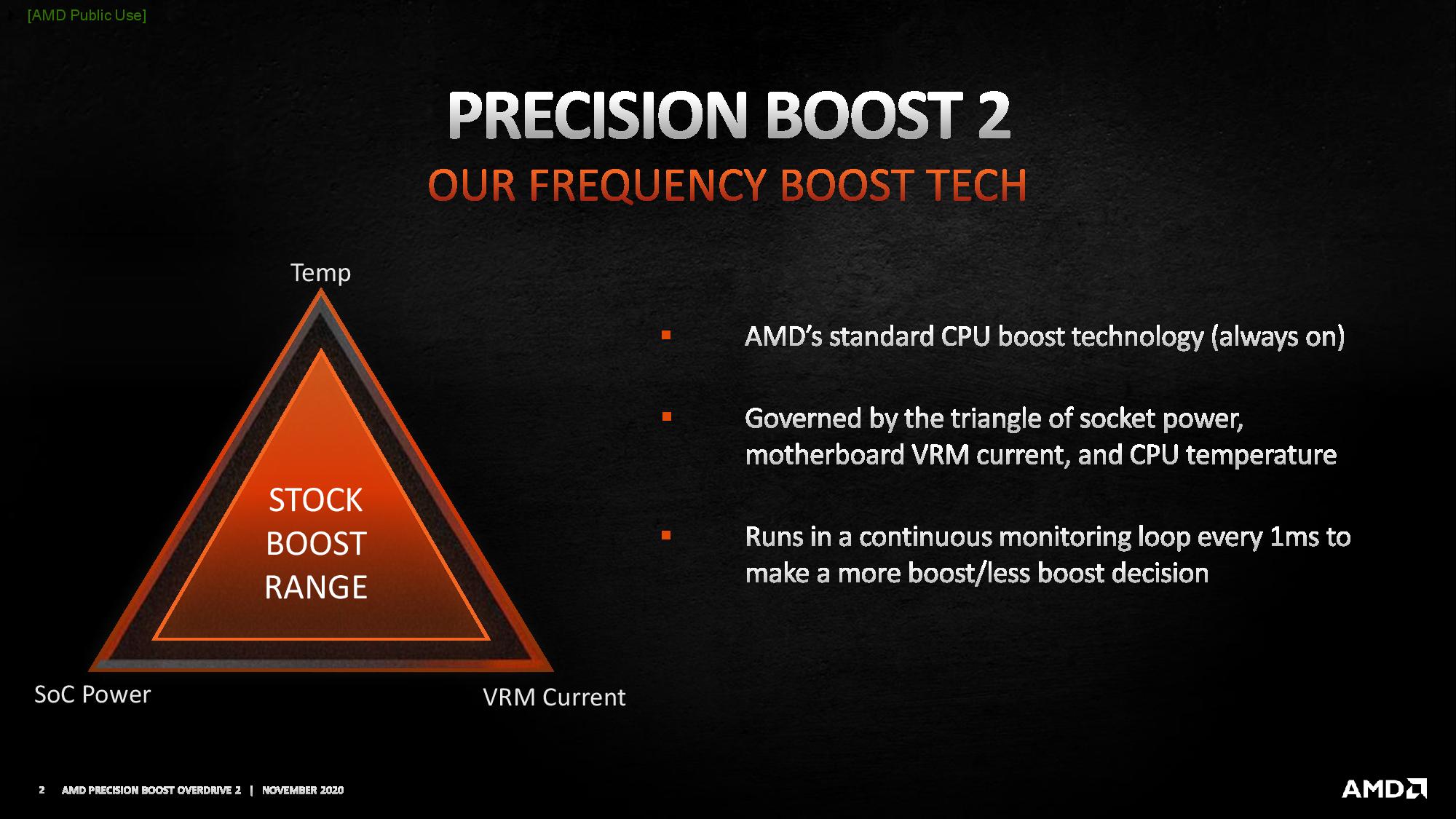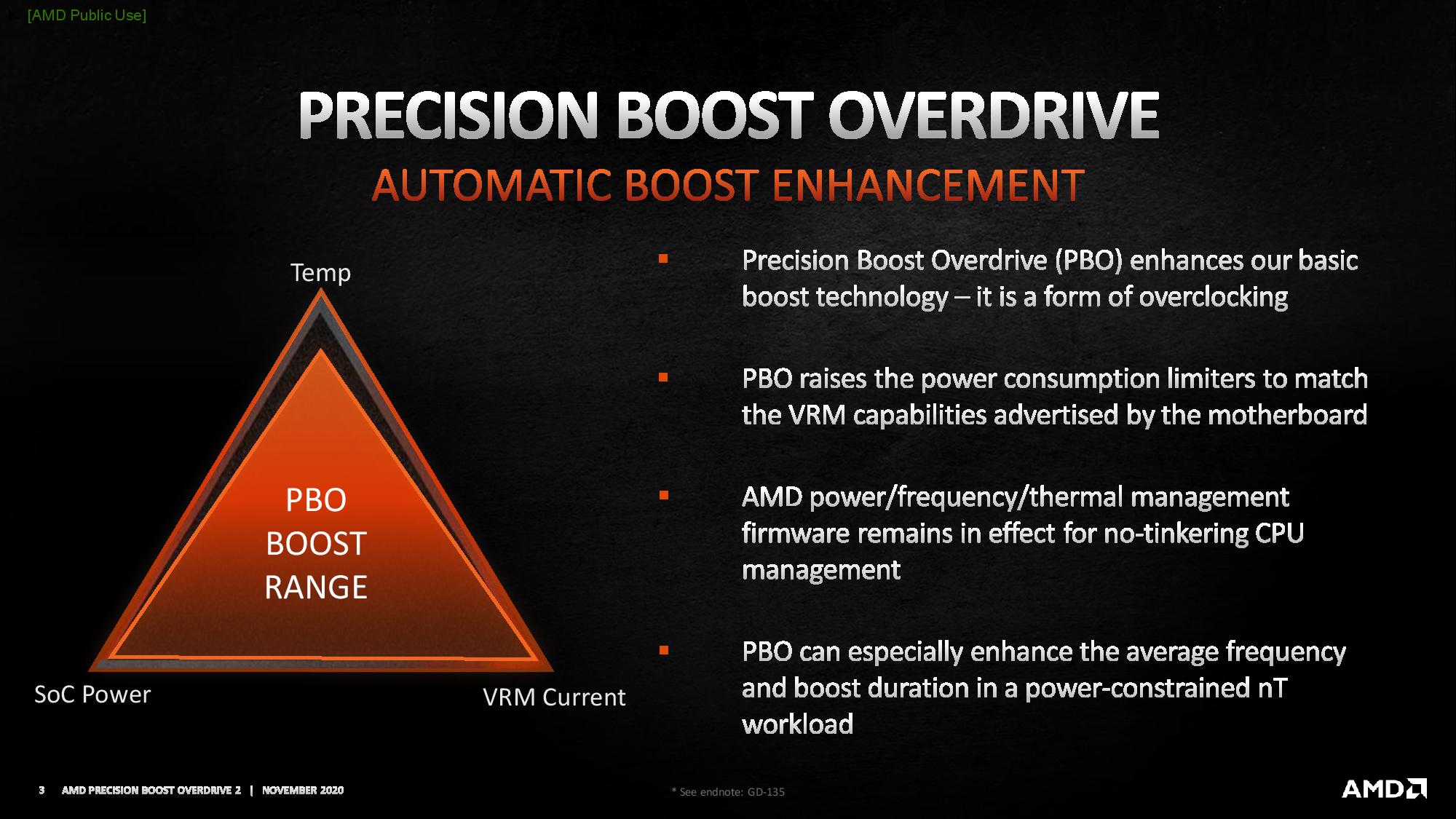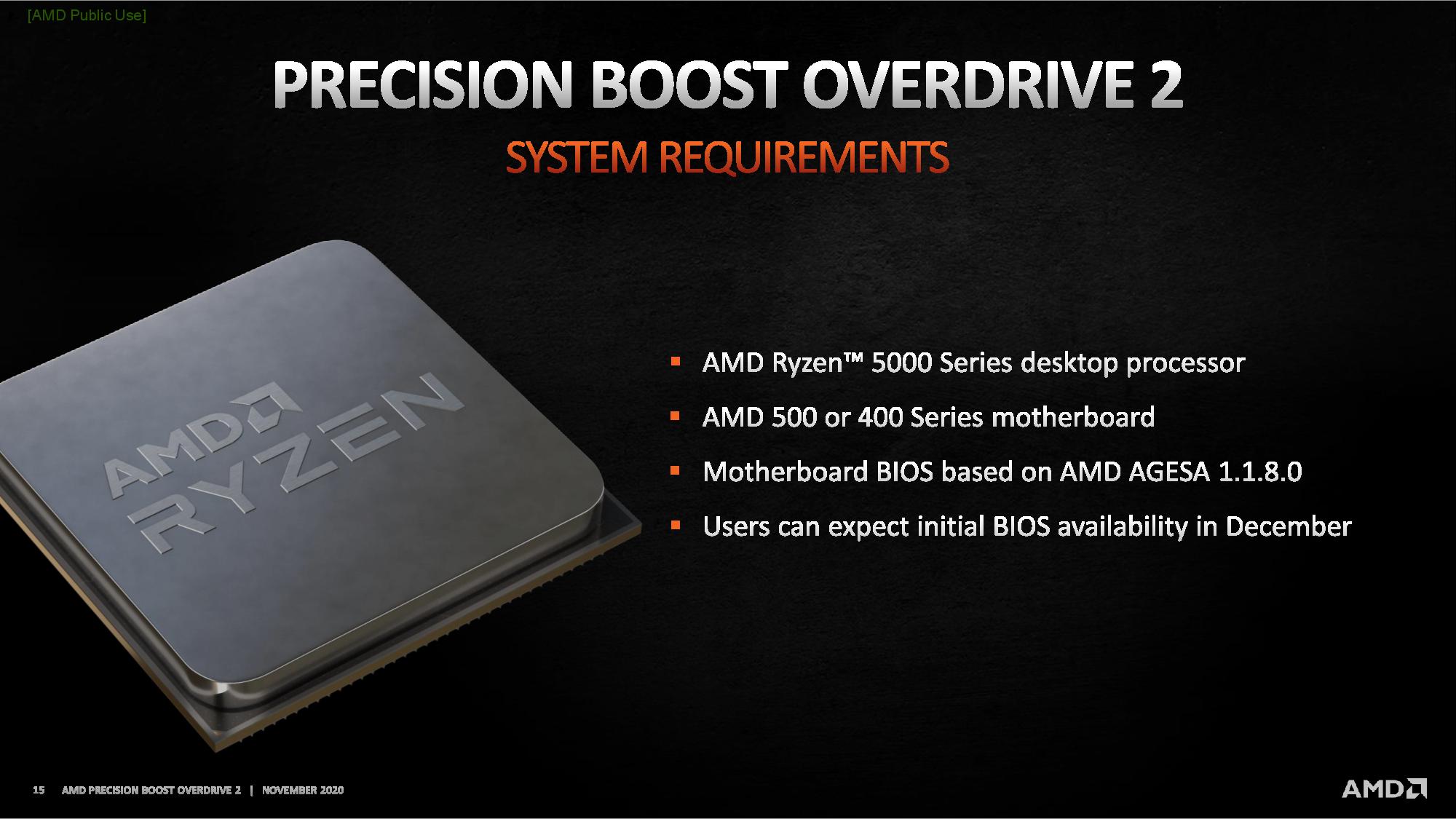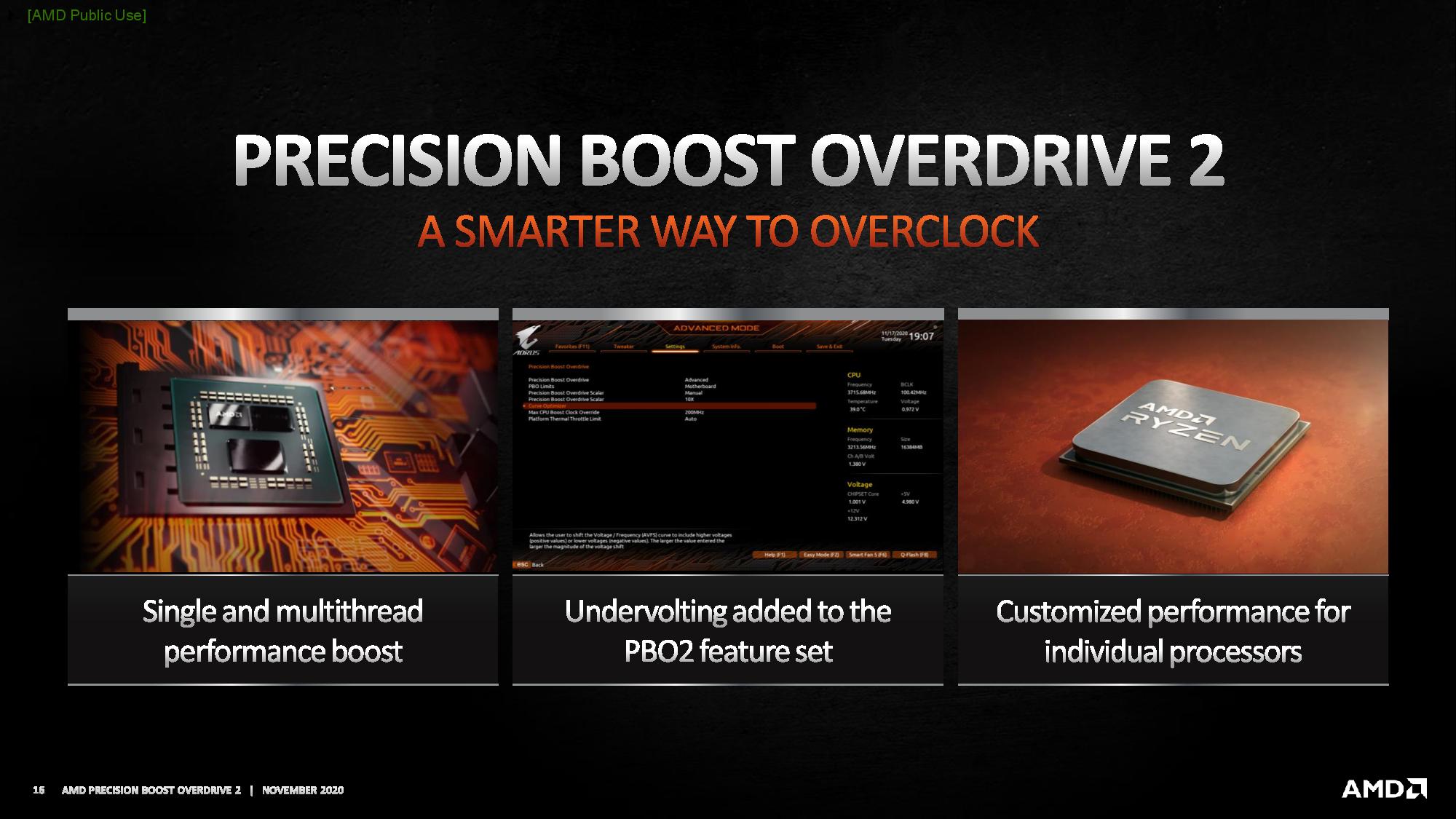AMD Introduces Precision Boost Overdrive 2, Boosts Single Thread Performance
Pump up the voltage
If you've already bought, or plan on buying, a Ryzen 5000 processor, AMD just made the deal a whole lot sweeter. AMD's Precision Boost Overdrive (PBO) introduced one-click hassle-free overclocking to the masses for the Ryzen lineup of processors. Still, while the tech boosts performance in multi-threaded workloads, it has long failed to benefit single-threaded workloads. That changes in December when AMD's new Precision Boost Overdrive 2 (PBO2) lands in BIOS patches. The new PBO2 boosts single-threaded performance while retaining the benefits of the existing multi-core boosts, and even adds a little extra oomph there, too.
The new PBO2 only works with Ryzen 5000 series processors, and AMD is also bringing in a new sophisticated undervolting technique to Ryzen 5000 processors for the undervolters among us.
We have plenty of testing that shows the benefits of PBO in our recent Ryzen 9 5950X and 5900X reviews, not to mention the Ryzen 5 5600X review. Still, AMD's impressive demo benchmarks show PBO2 basically enabling users to step up a tier over their existing processor in single-threaded performance. That's impressive given that AMD's Zen 3 processors have already soared to the top of the single-threaded performance CPU Benchmarks Hierarchy.
For example, PBO2 grants the Ryzen 7 5800X nearly the same exceptional single-threaded performance of the beastly Ryzen 9 5900X. As with all overclocking, and AMD's policy with the first-gen PBO, the new PBO2 invalidates your warranty. But given the relatively risk-free performance gains we've seen with PBO, and the fact that the automatic nature of the feature avoids using excessively dangerous amounts of voltage, we think PBO2 overclocking will continue to be the safest path to wringing out the best performance possible. That said, proceed at your own peril.





A few motherboards, like the MSI X570 Godlike and the Gigabyte X570 Aorus Master, already support the feature in current BIOS patches, but PBO2 officially lands in new BIOS revisions carrying the 1.1.8.0 AGESA, which will come to the masses in December.
Silicon quality always varies from chip to chip, and based on how you did in the silicon lottery, your chip may have much higher overclocking potential than others. The PBO adaptive algorithm allows you to extract the utmost performance from your chip. As with first-gen PBO, the new PBO2 allows the processor to exceed the AM4 socket power limitations to boost performance based on your chips' capabilities, the power delivery given to the chip, and your cooling solution.





The new Curve Optimization feature opportunistically adjusts voltage based upon operating conditions, such as if the processor is idling or under heavy load. This increases the range and impact of overclocking or undervolting, and is an automated feature.
The feature now shifts from adjusting parameters via fixed voltages to applying new settings via "counts," which are worth approximately 3mV-5mW apiece. This gives the feature a dynamic range that allows for further automatic fine-grained tuning. Ryzen 5000 owners will have a range of 30 counts for adjustment. The adaptive algorithm adjusts these variables once every millisecond based on telemetry data fed over the Infinity Fabric from various on-chip sensors.
Notably, the counts can be applied on either a per-core or entire-chip basis.
Get Tom's Hardware's best news and in-depth reviews, straight to your inbox.
PBO2 will debut as a BIOS-only option initially, but AMD plans to roll it into its Ryzen Master software early next year. For now, if you have a supported BIOS, you can activate the new automated overclocking feature by switching the BIOS settings to the 'motherboard' option, then enabling a higher PBO scalar limit and dialing in a 200 MHz max CPU boost override. From there, flip the switch on Curve Optimizer, and you're off to the races.



Here we can see AMD's claimed performance gains with PBO2 enabled. As you can see, AMD says that the tech allows a Ryzen 7 5800X to boost to the level of a stock Ryzen 9 5900X in single-threaded work. As expected, engaging the feature boosts the Ryzen 9 5900X, too, bringing it to the level of the Ryzen 9 5950X.
Importantly, PBO2 not only retains the level of performance from the first-gen PBO in multi-threaded workloads, but also adds a bit of extra performance in threaded tasks, too.


PBO2 will work with the Ryzen 5000, and future, AMD processors. However, the tech will not be applied retroactively to previous-gen models, like Ryzen 3000 chips. You'll need either a 500- or 400-series motherboard and a new BIOS based on version 1.1.8.0 AGESA. Those will roll out in December to all users, free of charge.
As you would imagine, we're already working on testing the new feature and doing a more expansive write-up on the tech. Stay tuned.

Paul Alcorn is the Editor-in-Chief for Tom's Hardware US. He also writes news and reviews on CPUs, storage, and enterprise hardware.
-
spongiemaster Reply
Are there other benchmarks that have been revealed besides the Cinebench results here? 5800x went from 628 to 638. That's a 1.6% improvement. 5900x improved by 1.9%. You call that boosting single thread "tremendously?" You have tremendously low standards if less than 2% qualifies for that label.Admin said:AMD introduces its new Precision Boost Overdrive 2 tech that boosts the overclocking capability of Ryzen 5000 series processors.
AMD Introduces Precision Boost Overdrive 2, Boosts Single Thread Tremendously : Read more -
saunupe1911 PBO overclocking is very confusing. I have a 5900x and Gigabyte X570 Aorus Master. I don't see any performance benefits except higher voltage with PBO turned on. Cinebench and gaming performance was basically equal to default settings as you mentioned in your graph.Reply
I kept it simple and set the CPU clock to 4400Mhz and voltage to 1.20. This all core overclock is much more efficient while actual voltage rarely goes over 1.14. PBO had it going up to 1.3. -
Gomez Addams What an ingenious scheme. You convince your customers to try a utility that provides a "tremendous" performance increase of less than 2% and they will voluntarily void their warranty. I bet someone in the support group came up with this idea.Reply -
InvalidError Reply
Got to appreciate the dichotomy of not condoning overclocking on one hand while promoting the benefits and the tools facilitating voiding your warranty on the other.Gomez Addams said:What an ingenious scheme. You convince your customers to try a utility that provides a "tremendous" performance increase of less than 2% and they will voluntarily void their warranty. I bet someone in the support group came up with this idea. -
TCA_ChinChin Reply
Yet another egg in the "AMD is not your friend, AMD is a company" basket.InvalidError said:Got to appreciate the dichotomy of not condoning overclocking on one hand while promoting the benefits and the tools facilitating voiding your warranty on the other. -
waltc3 I'm running PBO on my 3900X with the latest 1.1.0.0 AGESA--well, been running it for the last 12 months at least (x570 Aorus Master)--and I routinely get 4.65GHz max single-core boost--air-cooled, stock fan, stock clocks, on 3-5 cores (according to HWinfo). From what I've read the main difference between Zen2 PBO and Zen3 PBO is not just a bit higher max-single-thread boost clocks (which are lost if you manually overclock all the cores as boost is disabled) but 5000-series PBOs are also supposed to deliver the higher boost in a more sustained manner--at least "sustained" in comparison with Zen2 PBO boost clocks, that is. Yes, the Zen 2 max boost is there but only in lightly threaded workloads, and very briefly, too.Reply
It's fun to tinker with, but the differences are 200-300MHz, max, over what the CPU will do boosting or overclocked on all cores. Sometimes, people split hairs over a mere 50Mhz difference in max boost clocks. The single-threaded Cinebench tests are, I think, rather silly, as no one is going to render professionally using this program (or anything like it) in single-thread mode...;) Defeats the entire purpose of multicore SMT CPUs, imo! -
Makaveli ReplyGomez Addams said:What an ingenious scheme. You convince your customers to try a utility that provides a "tremendous" performance increase of less than 2% and they will voluntarily void their warranty. I bet someone in the support group came up with this idea.
When was the last time you had to RMA a processor i've been doing this 20+ years and never had to once. It will be fine aslong as your smart enough to be using proper cooling and not stock POS cooler. -
CerianK Based on some of the comments I might assume that not everyone is familiar with the intricacies of under-volting, which is part of the equation with PBO2. I know someone that used it to good effect on Zen, so perhaps Zen 3 will benefit from it as well. But because of the changes in Zen 2/3, it must be dynamically modulated to get a benefit (for Zen 3). Just a guess, but I would wait for independent reviews on PBO2 / new AGESA before passing judgement.Reply
Also, I understood the new AGESA would be required to assist with DDR4-4000 1:1 stability, for those marginally capable, but could not do it on the current AGESA. Just more knobs to twist and levers to pull, which is all good.
And yes, < 2% performance improvement is hardly noteworthy, which is why I found the 3000XT variants questionable, but those were a different SKU/price, which is not the case here. -
spongiemaster Reply
If the risk for damage is so low, why does it void the warranty?Makaveli said:When was the last time you had to RMA a processor i've been doing this 20+ years and never had to once. It will be fine aslong as your smart enough to be using proper cooling and not stock POS cooler.